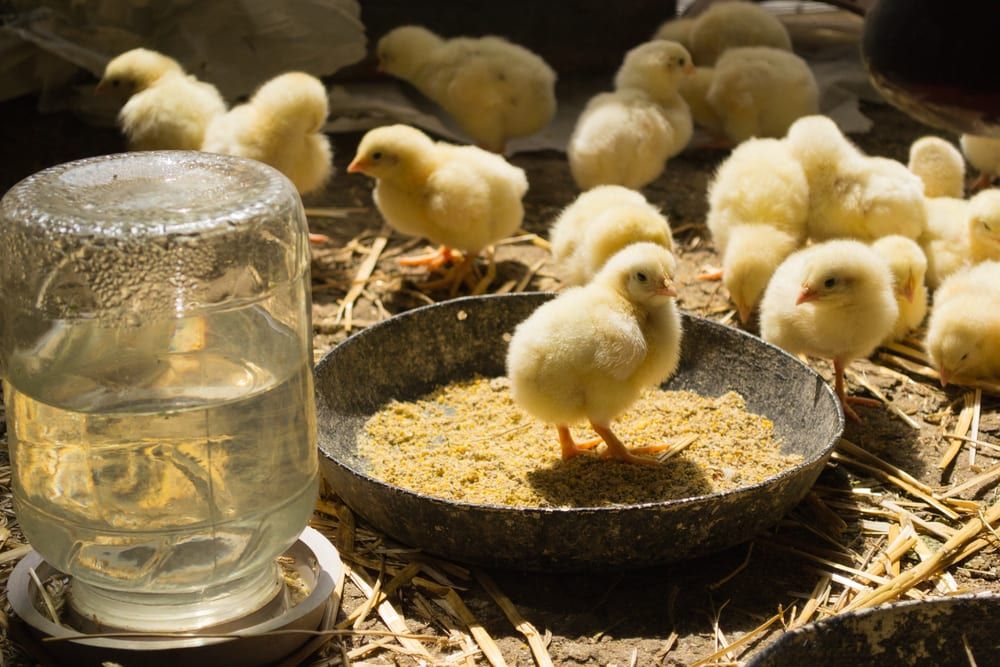Backyard Chickens
Beginner’s Guide to Raising Backyard Chickens
Raising backyard chickens can be multifaceted. It’s therapeutic, rewarding, fun, and can be a bit nerve-wracking for beginners!
There is literally tons of information about raising chickens and chicks and it’s difficult to sort through all of them to decide what’s right and wrong and what’s weird.
This comprehensive guide outlines everything you need to know about bird care from chick to chick.
Trust me I never stop learning and smiling when raising chickens.

Where to start.
Frequently Asked Questions:
Before you start raising chickens or chicks, you should ask yourself a few questions.
- Why are you raising them? – Eggs, meat or pleasure?
- Where will you put them?
- Are you ready to spend time with them?
- Are you willing to “clean” their coop when needed?
- Who will take care of you when you go on vacation?
- Can you raise chickens? If so, how many?
This question may seem frivolous, but many people don’t understand how much effort and time it takes to take care of chickens and the birds suffer accordingly. Chickens, like pets, need care and attention. Are you ready for this even in winter when there is a lot of snow and you need fresh water?
Once you have asked yourself these questions and have decided that yes, you can do this and want to do this, your next move is research.
Choosing the Correct Breed of Chicken
Here we are in the twenty first century with a stunning array of chickens to choose from.
How many different breeds are there?
In fact, no one knows for sure, but it’s estimated to be in the hundreds. There are birds specially bred for increased egg laying, good quality meat, fighting and plumage.
There are many types of chickens, but they all fall into one of four categories:
- Traditional Breeds: The Livestock Conservancy defines traditional chickens as naturally raised chickens that are slow-growing, long-lived and capable of productive lives. outdoor life. The breed must also meet the American Poultry Association’s standards for that breed.
- Egg-Laying Breed: These hens were bred to produce large numbers of eggs in a short production period.
Leghorns, like Australorps, are good examples of egg production. - Dual-Purpose Breed: These chickens are the best of both worlds in terms of usability. They are productive in the egg part and grow large enough for later use as meat poultry.
- Meat Breed: As the name implies, a chicken breed raised for meat. They grow very, very fast. They gain weight at an alarming rate and are ready for slaughter in about nine weeks.
Planning and Buying Your Chickens
It’s time to dive in! You want chickens and you know what breed you want, but you don’t know where to start.
You have several options when buying your first chicken.
Let’s consider the pros and cons of each option. You can buy hatching eggs, chicks, pullets or adult birds.
Each choice has its strengths, but it really comes down to what you think is best for you.
Pullets are more expensive in terms of care, feeding and time spent raising the birds. Adult chickens in their prime are the most expensive. Rescue hens and older chicks are generally cheaper than pullets but more expensive than chicks.
- Hatching Eggs: These are fertilized eggs that you need to incubate. If you are new to chickens, I don’t recommend that you get hatching eggs unless you really know what you are doing. Although incubation is fairly straightforward, there definitely is an art to it.
- Chicks: This is the most used and wise choice for novices. You can select which breed(s) you want and when you want them. You typically get chicks at one day old.
- Pullets: Pullets are birds aged between four to six months. The chicks have been reared to adulthood and are usually sold at point of lay, meaning the pullet is about to lay her first egg anytime soon!
- Adults: Adult hens are more difficult to come by as breeders like to move birds out before they get too old since they eat more. A common source of adult hens is animal shelters or rescue sanctuaries.
How many should I get?
In general, you can calculate the average number of chicks you need. If your bird only eats eggs, should you consider how many eggs you are currently using per week?
A hen lays an average of 4-5 eggs per week. Just in case, throw in a few extra chicks and you’ll get your number!
For example, it takes 6 chickens to get 16 eggs in a week (usually 4 eggs are enough, but I added 2 chickens just in case).
What should I look out for?
All birds should have clear, bright eyes. They should be curious about their environment and you. Feathers or fluff should look clean with good coloring.
If a bird, regardless of age exhibits any of these signs you should avoid buying it.
- Sleepy, lethargic
- Hunched into a ball
- Sitting by itself
- Reluctant to move
- Any nasal/eye discharge
- Blocked vent
How to raise chicks
Now that you have done your research, decided on your breed, what happens now?
If you have ordered them online, the website you have ordered them from will likely carry all the things you need to make your chicks a home.
If you are buying from a farm store, make sure you have everything you need for the chicks in advance. Farm stores usually sell a large amount of chick related items.
Make sure that you know what to get otherwise you could be parting with hard earned dollars for something you don’t want or need. Here’s a list of the essentials!
Brooding Box
This can be as simple as a cardboard box. It needs to be tall enough to keep the chicks from jumping out. It needs to be large enough for a food dish, water dish and the chicks.
It also needs to be draft proof – cold drafts can kill chicks very quickly.
Brooding boxes come in all shapes, sizes and costs. If you are not sure whether you will be brooding chicks again, get the cheapest brooder to start with – you can upgrade yourself later.
Bedding
Something soft like pine shavings. These are sold in small bales at most farm stores and they are inexpensive.
If your brooder box has a slick floor (like plastic), lay some paper towels under the bedding so they can grip and stand properly otherwise they may develop problems with standing and walking.
Warmth
Chicks require warmth – lots of it.
They do not have true feathers until they are around 6-7 weeks old so cannot regulate their own temperature, so you must help them.
You can use a heat lamp or ‘Electric hen’ heat plate.
They will need to be warmed for around 6-7 weeks or until the ambient temperature is roughly the same as the brooder
During the first week the temperature at chick level will need to be 95F. This will reduce by 5 degrees each week until ambient temperature is reached.
How do you know if they are warm enough?
If they are all huddled in a bunch, they are too cold; if they are spread to the brooder’s edges, they are too hot; if they are dotted all over, they are just right. A thermometer will help you with this too, but base your judgment on the chicks’ behavior.
Food
Chicken food comes in a wide array of choices that can be confusing, so here’s the scoop. It is recommended that you feed your chicks the following:
- 0-8 weeks: 18-20% starter feed crumbles
- 8-14 weeks: 16-18% starter/grower
- 15-18 weeks: 16% finisher
- 18 weeks upward: 16% layer feed
Chick feed can come as medicated or un-medicated.
The medicated feed is medicated with a coccidiostat, which protects them from coccidiosis – a terrible disease.
If your chicks have been vaccinated at source for coccidia, then do not use medicated feed.
Chicks are messy; they will scratch their food all over the place, poop in it and get their bedding in it, so you need a feeder that will eliminate some of that mess.
Once they start eating greens such as short grass or dandelions, they will need a small dish of chick grit to help their digestion and make sure they don’t get an impacted crop.
Water
Water is essential to the well-being of all living things, and chickens are no exception. The water should be at Goldilocks temperature. Not too hot, not too cold, just right.
First dip each chicken’s beak in water so they know where they are so they can all find the water bowl. Do the same with your food plate.
If the chicks are only two days old, you should add a few clean pebbles or balls to the bucket to keep them from falling and drowning.
After about a week, you can remove the chicks as they are large enough not to drown.
You can add an electrolyte/vitamin supplement to the water for the first few days to get them off to a good start.
Change the water frequently (several times per day) as they will kick bedding etc. into the water regularly.
Hygene
Whoever said ‘cleanliness is next to godliness’ never kept chickens. I have already told you that chicks are messy, so you’ll be “room service” for them!
Incubators, feeders and drinkers must be kept clean. The stool should be cleaned daily and the filler should be changed as often as needed. They should be replaced as soon as they get wet.
Remember that broilers are very warm, dung and damp, which is a perfect environment for bacteria to thrive.
Clean and disinfect feeders and drinkers at least every other day. If your chickens are dirty like mine, you will have to throw away a lot of feed. As soon as you put poop in the food trough, the food is gone.
Of course don’t forget to sanitize and wash your hands before handling or handling food!
Security
A broiler full of chickens needs to be somewhere safe from predators and classify pets as predators as well.
If kept indoors, it should be kept in a separate room or in a secure box lid to prevent Fido and Fluffy from accessing these little fluffy balls.
Do not place in areas such as bedrooms, dining rooms and kitchens. They cause a lot of dust and dander, and people with dust allergies can have problems at home.
Keeping chickens in farm buildings requires excluding possible predators nearby.
Rats love chickens, as do foxes, weasels, raccoons, and numerous other carnivores.
Intensive care is required until approximately 12 weeks of age.
So there you have it – the complete guide to raising chicks and chickens.
